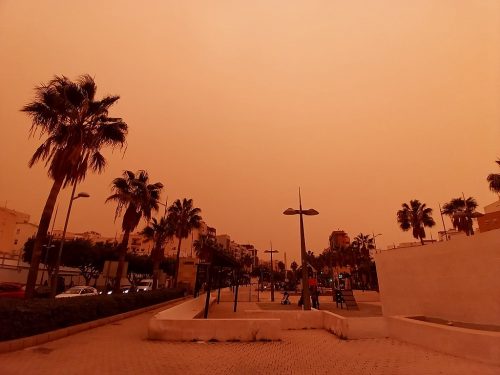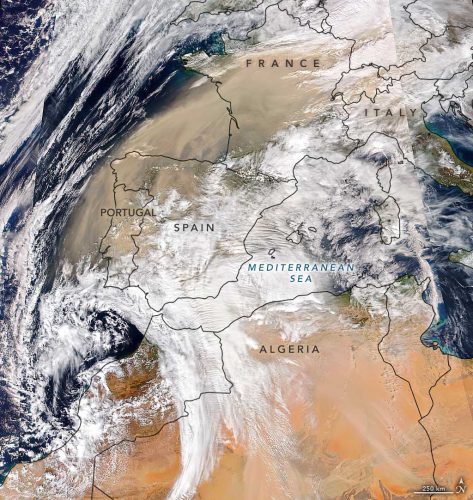Madrid, Spain —(Map)
Over the last two days, much of Spain has been coated with dust, and the skies have turned bright orange. A huge cloud of dust from the Sahara Desert is causing the strange weather. The dust cloud is expected to spread to other parts of Europe.
Across much of Spain on Tuesday morning, a thin layer of red dust coated everything outside. From streets to sidewalks to balconies, everything was covered with a layer of dust. This included cars, buses, trees, and plants.
😕
This image has not been loaded because of your cookie choices. To view the content, you can accept 'Non-necessary' cookies.
Over the last two days, much of Spain has been coated with dust, and the skies have turned bright orange. A huge cloud of dust from the Sahara Desert is causing the strange weather. The view of Granada above is almost completely lost in the dust cloud.
As the sun rose, the dust in the air turned the skies in some cities a strange orange. The cause of the dust and unusual sky color wasn’t a forest fire, but dust from the Sahara Desert.
Every year, a large cloud of dust rises from the Sahara Desert. It’s called the Saharan Air Layer. Usually, it crosses the Atlantic Ocean as part of a natural cycle that helps develop farmland and beaches in Central and South America.

(Source: Eduardo Milla [CC BY-SA 4.0], via Wikimedia Commons.)
But sometimes, depending on the weather, the layer of dust gets forced to the north. Large sandstorms in northern Africa lift sand and dust into the air, where it gets blown toward Spain. Though the particles in the air come from sand, they’re much more like dust than sand at a beach.
These kinds of storms aren’t unknown in Spain. In fact, it has a special name. It’s called a “calima”.
This calima is so large that it can be seen from space. A NASA scientist who studies weather in the atmosphere says it’s like a river of dust in the air. That river of dust has met with a river of wet air driven by strong winds. Those winds come from Storm Celia, which hit the Canary Islands on Monday.

(Source: Joshua Stevens, NASA’s EarthObservatory.)
Spain’s weather service described the dust storm as being “very intense”. At one point on Tuesday, the air quality in Madrid was the worst in the world. Government health experts warned people not to go outside without a mask, and to keep their windows and doors closed at home.
Because the dust was mixing with the wet air from Storm Celia, in some areas, tiny bits of dust got trapped in the rain. People in some cities, like Malaga and Navarra, reported that it was “raining mud”. In other places, the dust changed the color of the snow on the ground.
😕
This image has not been loaded because of your cookie choices. To view the content, you can accept 'Non-necessary' cookies.
People in some Spanish cities, like Malaga and Navarra, reported that it was “raining mud”. In other places, like this ski resort near Madrid, the dust changed the color of the snow on the ground.
The dust cloud continued to spread north and west, hitting both France and the United Kingdom. The dust is expected to keep spreading, possibly as far north as Denmark.
But the effects won’t be nearly so strong. In some places it may appear to be slightly foggy. In others, the main effect will be very colorful sunsets.
Some weather experts warn that climate change could make dust storms from the Sahara desert even more intense in the future.
😕
This map has not been loaded because of your cookie choices. To view the content, you can accept 'Non-necessary' cookies.
